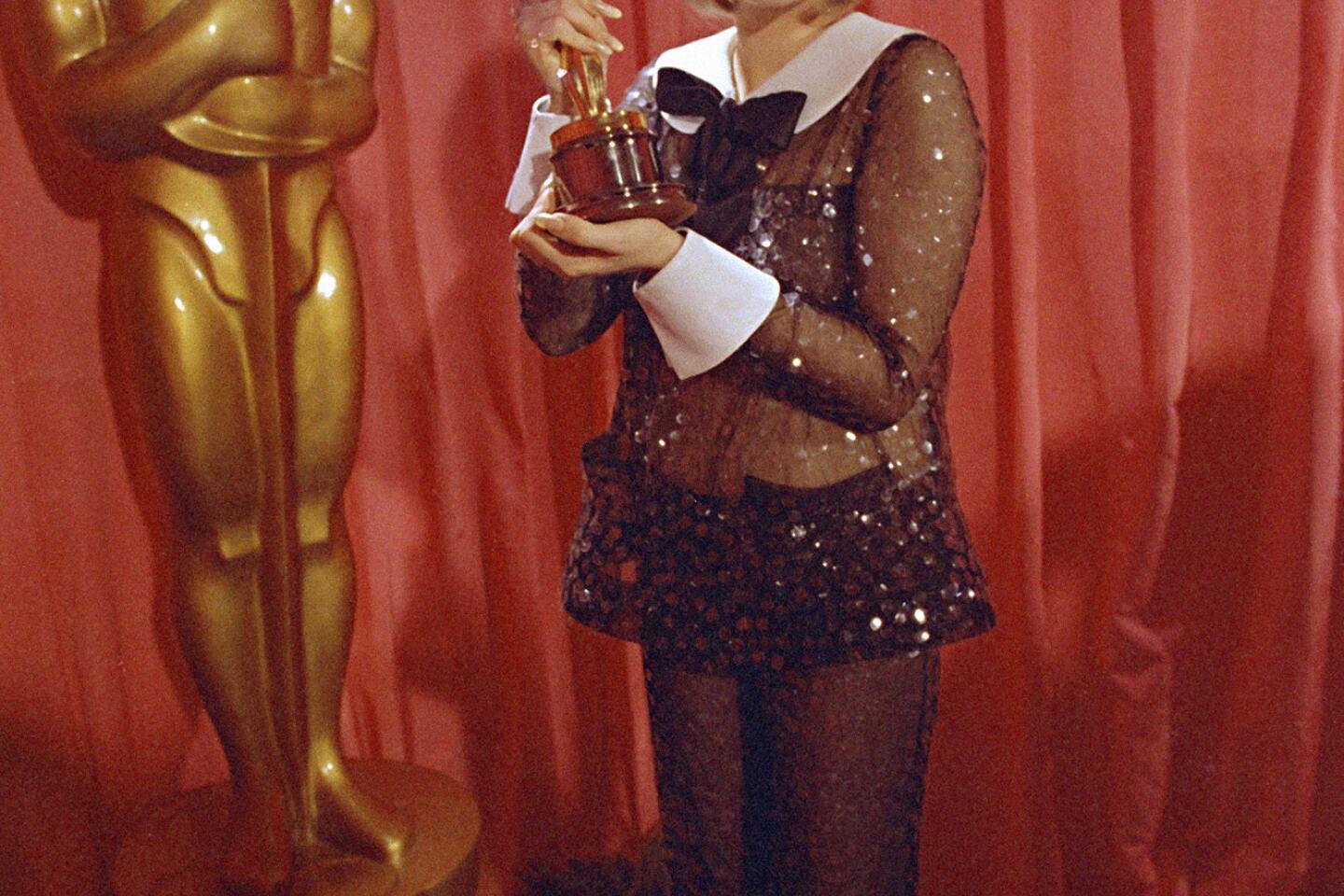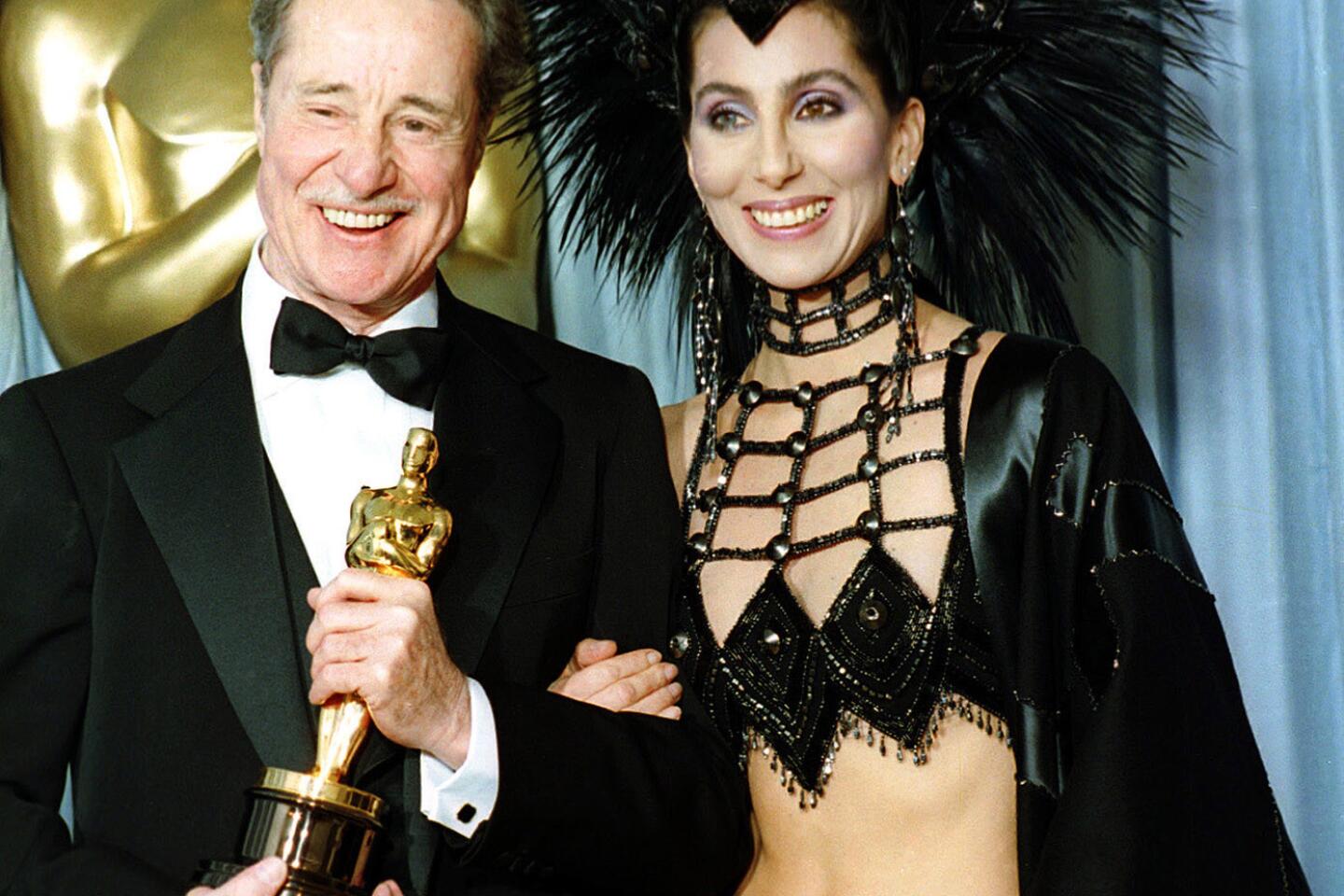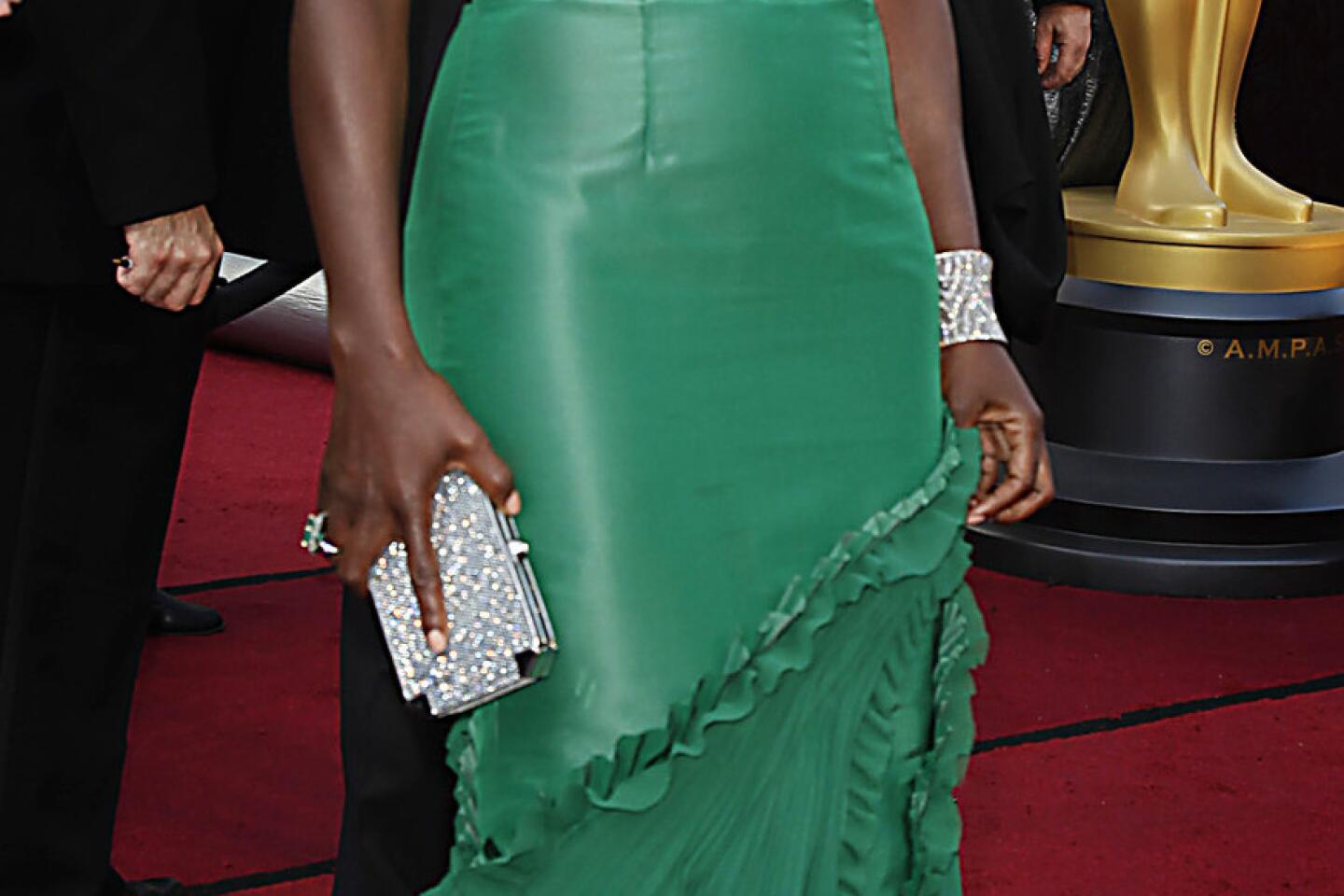How Oscars’ fashion show changed through the decades
- Share via
The Academy Awards are the biggest fashion runway on the planet. When Jennifer Lawrence, Anne Hathaway, Amanda Seyfried and other stars step out onto the red carpet Sunday, they will be primed to talk as much about what and who they are wearing as about the films that got them there.
But it wasn’t always this way. The first Academy Awards, held in 1929 at the Roosevelt Hotel in Hollywood, was a low-key affair — a small dinner and 15-minute ceremony. There was no red carpet, and no one’s dresses were on display since the event was not televised. When Janet Gaynor picked up her lead actress award, she looked rather ordinary, in a dress that likely was bought in the children’s section of a department store (she was only 5 feet tall).
Fast forward to the 21st century, where the Internet has provided a forum in which everyone can voice an opinion on what Hollywood wears, from Angelina Jolie’s leg-baring black Versace, to Gwyneth Paltrow’s white Tom Ford cape-and-gown ensemble at last year’s event.
Here’s a look back at how Oscars red carpet fashion has evolved.
1930s
Before the world could see the show
1931: Norma Shearer’s husband, MGM studio head Irving Thalberg, thought she needed to ramp up her sex appeal to win a part in “The Divorcee” and hired costume designer Gilbert Adrian to help her get the right look. It worked. She got the part, took home a best actress award in 1931 and started a long-term collaborative relationship with the designer, foreshadowing today’s actresses who work with specific designers or stylists.
1936: Bette Davis injected politics into awards show fashion in 1936, when, nominated for best actress for her role in “Dangerous” — a film she disdained — she attended wearing a simple blue-and-white dress and coat designed by Orry Kelly. Her intention was to look like the hired help — which was what she felt like under contract to Warner Bros.
1937: Luise Rainer thought her chances of winning best actress for “The Great Ziegfeld” were so slim in 1937 that she planned to stay home. A last-minute phone call from boss Louis B. Mayer ordered her to the ceremony, and she ended up picking up her award in her nightgown — but it was actually a pretty chic-looking nightgown.
1940s
A mix of glamour and patriotism
1940: Rainer could get away with a nightgown in 1937, but things changed in 1940, the first year the awards were filmed, and stars and their studio bosses realized the PR potential of glamour dressing. That’s the year Vivien Leigh won for “Gone With the Wind,” wearing a red poppy-print chiffon gown by Irene Gibbons, designed to be worn without a bra, that was about as far removed as possible from the corsets and hoop skirts she donned to play Scarlett O’Hara. The gown would still look gorgeous today.
1942: Jimmy Stewart struck a patriotic note in wartime in 1942, wearing duds that came courtesy of Uncle Sam: his Army Air Corps uniform.
1944: Jennifer Jones wore diamond earrings that reportedly were on loan to her from Harry Winston. It is believed this was the start of the now-common practice of jewelers lending precious baubles for the big night.
1950s
Stars align with dawn of TV age
1951: The black Christian Dior gown Marlene Dietrich wore to present the foreign-language Oscar in 1951 set the actress apart from the mostly pastel-wearing crowd. A sexy bow at the hip and slit that showed a lot of leg helped revive her career — and cemented Dior’s place in Hollywood.
1951: Marilyn Monroe, also a presenter in 1951, had to deal with a ripped dress — that was quickly mended just before she went on stage, thereby avoiding what could have been one of the first celebrity wardrobe malfunctions.
In 1953, the Oscars were broadcast on television for the first time, and lest you think actresses of that day were more demure than today’s crop, a worried academy appointed costume designer Edith Head to be the program’s first “fashion consultant,” charged with making sure no one ran afoul of the censors. She kept bunches of flowers and pieces of lace backstage, ready to be used to hide any dangerously exposed décolletage.
1954: Audrey Hepburn slipped into a yellow lace Givenchy gown to accept her award for “Roman Holiday” in 1954, vaulting the designer into the international spotlight and creating a path to fame and fortune that fashion designers follow to this day.
1955: Edith Head, an eight-time Academy Award winner herself for costume design, outfitted dozens of actresses for awards ceremonies, and collaborated with Grace Kelly on the ice-blue sheath Kelly wore when she won the lead actress award for “The Country Girl” in 1955. The dress cost $4,000 — an eye-popping amount at a time when cars didn’t cost as much as that.
1960s and 1970s
Fashion picks for the show loosen up
1960: Janet Leigh sparkled in an Edith Head gown festooned with thousands of bugle beads in 1960, as the end of the studio system ushered in an era of anything-goes individuality.
1966-1978: Not convinced? There was the gold jumpsuit Julie Christie stitched up herself and wore when she accepted the lead actress award for “Darling” in 1966, the Arnold Scaasi bell-bottom pantsuit Barbra Streisand donned in 1969 to pick up her award for “Funny Girl,” Diane Keaton’s “Annie Hall” look by costume designer Ruth Morley in 1978 (Keaton was another recipient of the lead actress award) and Farrah Fawcett’s disco chain-mail dress by American designer Stephen Burrows in 1978.
1980s
A decade of glorious excess
1986, 1989: If the ‘60s and ‘70s were madcap, the ‘80s were all about excess. In 1986, Nolan Miller, costume designer on the television shows “Dynasty” and “The Love Boat,” was appointed as the Academy Awards fashion consultant, and looks became larger than life. Consider Cher’s Bob Mackie feather gown and headdress in 1986 and Demi Moore’s bustier and bike shorts in 1989.
1990s
Looks on loan — and for sale
1990: In 1990, Rodeo Drive retailer Fred Hayman took over as fashion consultant. Determined to avoid worst-dressed disasters, he established a dressing service at his store where stars could buy or borrow clothes for the ceremony. At the same time, cable TV networks began extensive red carpet coverage.
1990: The same year, Jodie Foster, Michelle Pfeiffer, Jessica Lange and Julia Roberts all wore soft, minimalist Armani — a breath of fresh air after the preceding decades, and millions of dollars’ worth of free publicity for the designer.
1995: Prada had its debut at the awards, dressing Uma Thurman (supporting actress nominee for “Pulp Fiction”) in lavender chiffon with a dusting of sequins at the hem.
1996: The next year, Dolce & Gabbana designed its first Oscar gown, a copper-colored creation, for lead actress winner Susan Sarandon of “Dead Man Walking.”
1996: Also in 1996, Sharon Stone wore a Valentino ball skirt with a Gap turtleneck pulled from her closet. But first she called Gap Chief Executive Millard Drexler and persuaded him to make a donation to her charity in exchange for plugging Gap on the red carpet.
2000s
Designers get closer with stars
2001: Vintage began to make a splash on the red carpet, as stars sought out individual looks. Renée Zellweger and Julia Roberts went elegantly vintage in 2001, Zellweger in a Jean Dessès gown from the 1950s and Roberts in Valentino circa 1982.
2001: In a flash of true individuality, Björk chose a Marjan Pejoski swan dress with matching egg purse in 2001.
For the most part, the 2000s have been about the symbiotic relationships between high-end designers and the stars who wear their clothes, often for a handsome sum.
2002: Halle Berry brought Elie Saab to prominence in 2002, wearing his burgundy gown to pick up her lead actress award for “Monster’s Ball.”
2005: Charlize Theron wore Dior in 2005, after becoming the face of Dior’s J’Adore fragrance.
2012: Viola Davis was one of last year’s most-watched nominees before the Oscars, giving a boost to a number of high-end designers. She wore a dreamy white and gold Marchesa gown to the Screen Actors Guild Awards; a one-shoulder, wine-colored Emilio Pucci at the Golden Globes; a bright pink dress by Juan Carlos Obando at the Academy Awards nominees luncheon. But at the Oscars, her green mermaid gown by Vera Wang was upstaged when attention shifted to her hair. She ditched her wig and wore her short hair natural.












